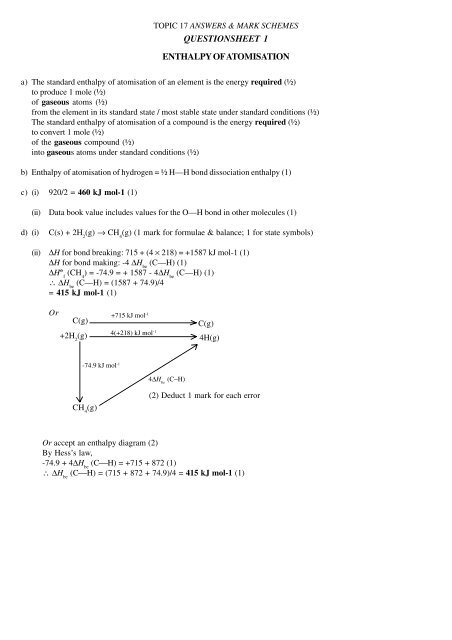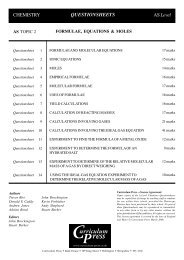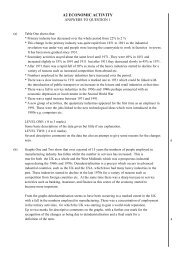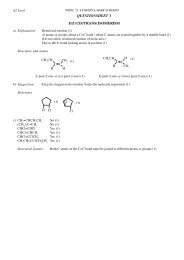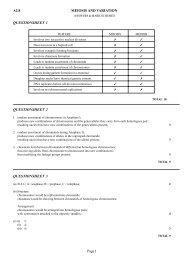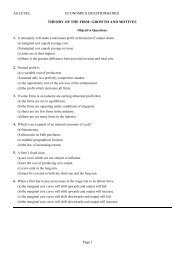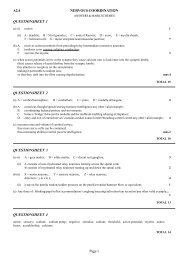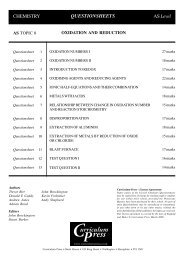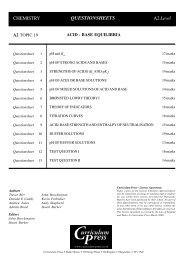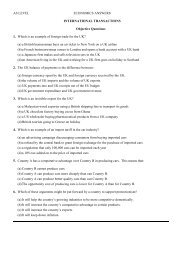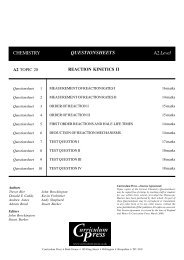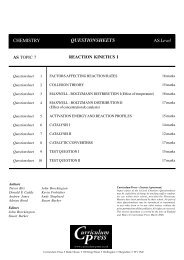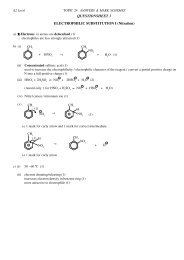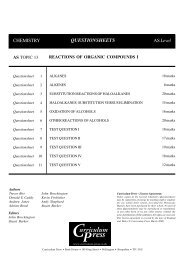questionsheet 1 enthalpy of atomisation - practise with past papers ...
questionsheet 1 enthalpy of atomisation - practise with past papers ...
questionsheet 1 enthalpy of atomisation - practise with past papers ...
- No tags were found...
You also want an ePaper? Increase the reach of your titles
YUMPU automatically turns print PDFs into web optimized ePapers that Google loves.
TOPIC 17 ANSWERS & MARK SCHEMESQUESTIONSHEET 4BORN-HABER CYCLES IIa) (i)Mg + (g) + e − + Cl(g) (½)+121 kJ mol -1 (½)-364 kJ mol -1 (½)Mg + (g) + Cl − (g) (½)Mg + (g) + e − + ½Cl 2(g) (½)+736 kJ mol -1 (½)Mg(g) + ½Cl 2(g) (½)-756 kJ mol -1 (½)+150 kJ mol -1 (½)Mg(s) + ½Cl 2(g) (½)∆Hê f(MgCl) (½)MgCl(s) (½)(ii) ∆Hê f(MgCl) = +150 + 736 + 121 + (-364) + (-756) (1)= -113 kJ mol-1 (1)(iii) The formation <strong>of</strong> MgCl 2is more exothermic than MgCl (1)Hence MgCl 2is more stable / at a lower energy level than MgCl (1)b) Lattice <strong>enthalpy</strong> <strong>of</strong> MgCl (1)c) Second ionisation energy <strong>of</strong> magnesium (1)Lattice <strong>enthalpy</strong> <strong>of</strong> MgCl 2(1)d) Greater or less than ∆Hê lattice(MgCl 2) Less (1)Explanation Mg+ has a smaller charge than Mg 2+ (1) and is larger (1)Or Mg+ has a lower surface charge density than Mg 2+ (2)
TOPIC 17 ANSWERS & MARK SCHEMESQUESTIONSHEET 5ENTROPY AND FREE ENERGY CHANGEa) ∆Gê Standard free energy change / free energy change at 298 K and 1 atm (½)kJ mol -1 (½)TAbsolute temperature / temperature in kelvins (½)K (½)∆Hê Standard <strong>enthalpy</strong> change / <strong>enthalpy</strong> change at 298 K and 1 atm (½)kJ mol -1 (½)∆Sê Standard entropy change / entropy change at 298 K and 1 atm (½)J K -1 mol -1 (½)b) (i) Decrease (1)O 2gas (disordered) → MgO solid (ordered) (1)(ii) Increase (1)Mg solid (ordered) → H 2gas (disordered) (1)(iii) Remain approximately the same (1)Reactants and products are all gaseous (½)No change in the number <strong>of</strong> gas molecules (½)(iv) Increase (1)Increased number <strong>of</strong> gaseous molecules (1)c) (i) Total entropy <strong>of</strong> products = (2 × 213.6) + (3 × 69.9) = 636.9 J K -1 mol -1 (1)Total entropy <strong>of</strong> reactants = (160.7) + (0) = 160.7 J K -1 mol -1 (1)∴ ∆Sê = 636.9 – 160.7 = 476.2 J K -1 mol -1 (1)(ii) ∆Gê = -1367.3 – (298 × 476.2 × 10-3) (1)= -1509.2 kJ mol -1 (1)
TOPIC 17 ANSWERS & MARK SCHEMESQUESTIONSHEET 8TEST QUESTION IIa) Mg(s) + ½O 2(g) → MgO(s) (2)Award (1) for correctly balanced equation and (1) for correct state symbols.b) (i)Mg 2+ (g) + O 2− (g)Mg 2+ (g) + 2e − + O(g)+1451 kJ mol -1-142 kJ mol -1 +844 kJ mol -1Mg 2+ (g) + e − + O − (g)Mg + (g) + e − + O(g)+738 kJ mol -1Mg(g) + O(g)+249 kJ mol -1-3884 kJ mol -1Mg(g) + ½O 2(g)+147 kJ mol -1Mg(s) + ½O 2(g)∆Hê f(MgO)MgO(s)(4) Deduct 1 mark for each error.(ii) ∆Hê f(MgO) = [+147] + [+249] + [+738] + [+1451] + [-142] + [+844] + [-3884] (1)= -597 kJ mol -1 (1)c) ∆Sê = [27.0] – [(32.7) + ½(205)] (1)= -108.2 J K -1 mol-1 (1)d) (i) ∆Gê = ∆Hê - T∆Sê (1)= [-597 × 103] – [(298) × (-108.2)] (1)= -564 800 J mol -1= -564.8 kJ mol -1 (1)(ii) Reaction has high activation energy (1)Energy is required to form Mg 2+ and O 2- ions before lattice <strong>enthalpy</strong> can be released (1)∴ reaction is infinitely slow (1)Maximum 2 marks
TOPIC 17 ANSWERS & MARK SCHEMESQUESTIONSHEET 9TEST QUESTION IIIa) (i) The <strong>enthalpy</strong> change when 1 mole <strong>of</strong> gaseous ions (1)becomes hydrated by a large / infinitely large quantity <strong>of</strong> water (1)(ii) The <strong>enthalpy</strong> change when 1 mole <strong>of</strong> the solid (1)is dissolved in a large quantity <strong>of</strong> water / to give an infinitely dilute solution (1)b) (i)Mg 2+ (g) + 2Cl − (g)∆Hê hyd(Mg 2+ (g))+2493 kJ mol -1Mg 2+ (aq) + 2Cl − (g)MgCl 2(s)-728 kJ mol -1-155 kJ mol -1 (3) Deduct 1 mark for each error.Mg 2+ (aq) + 2Cl − (aq)(ii) ∆Hê solution= ∆Hê lattice+ ∆Hê hyd(cation)+ ∆Hê hyd(anion)(1)(iii) -155 = +2493 + ∆Hê hyd(Mg 2+ (g)) + [-728] (1)∴∆Hê hyd(Mg 2+ (g)) = [-155] + [-2493] + [+728]= -1920 kJ mol -1 (1)c) (i) Value becomes more negative (1)(ii) Size <strong>of</strong> the metal cation increases (1)∴ charge density <strong>of</strong> the metal cation decreases (1)(iii) Decrease in lattice <strong>enthalpy</strong> is much greater than decrease in hydration <strong>enthalpy</strong> (1)∴ ∆Hê solutionbecomes more negative and solubility increases (1)
TOPIC 17 ANSWERS & MARK SCHEMESQUESTIONSHEET 10PRINCIPLES OF ELECTROCHEMICAL CELLSa) (i) Oxidation Zn(s) → Zn 2+ (aq) + 2e - (1)Reduction Cu 2+ (aq) + 2e - → Cu(s) (1)(ii) Zn(s) + Cu 2+ (aq) → Zn 2+ (aq) + Cu(s) (1)(iii) Solution changes colour from blue to colourless (1)Pink / red solid is precipitated (1)b) (i) Zinc rod becomes smaller (1)Copper rod becomes larger (1)Blue colour <strong>of</strong> CuSO 4(aq) fades (1)(ii) With reaction in a cell, energy is released as electricity (1)With reaction in a beaker, energy is released as heat (1)c) (i) For a redox reaction to occur, there must be oxidation at one half-cell (1)and reduction at the other (1)Or electrons are released at one (1)and have to be accepted at the other (1)(ii) To complete the circuit (1)Contains saturated KNO 3(aq) / KCl(aq) (1)as a gel or saturated on filter paper or in sintered glass salt bridge(1)(iii) Electrons (1)which flow from Zn to Cu (1)(iv) K + ions to the Cu half-cell (1)NO 3-/ Cl - ions to the Zn half-cell (1)SO 42-ions from the Cu half-cell to the Zn (1)
TOPIC 17 ANSWERS & MARK SCHEMESQUESTIONSHEET 12MEASUREMENT OF ELECTRODE POTENTIALSa) (i) It is impossible to find the potential <strong>of</strong> a single electrode (1)because we can only measure a potential difference (1)Or because a voltmeter has two terminals and must be connected to two electrodes (1)(ii)H 2(g) (½) 1 atm (½)HCl(aq) or H 2SO 4(aq) (½)[H] + = 1 mol dm -3 (½)at 298 K (1)Pt foil (1)b) (i) Reduction Fe 3+ (aq) + e - → Fe 2+ (aq) (1)Oxidation Cu(s) → Cu 2+ (aq) + 2e - (1)(ii) 2Fe 3+ (aq) + Cu(s) → 2Fe 2+ (aq) + Cu 2+ (aq) (1)(iii) E cell= E + – E –+0.43 = E + – 0.34 (1)E + = + 0.77 V (1)(iv) E cell= E + – E –E cell= 0.43 – (– 0.37) (1)E cell= 0.71 V (1)
TOPIC 17 ANSWERS & MARK SCHEMESQUESTIONSHEET 14PREDICTION OF REDOX CHANGES FROM STANDARD ELECTRODE POTENTIALSa) (i) I – (½) & S 4O 62–(½)(ii)Cl – (½) & SO 42–(½)(iii) None (1)(iv) Fe 3+ and I 2(½) & Cr 3+ (½)b) (i) Eê cell=+ 0.77 – (+ 1.23) = – 0.46 V (1)Outcome No reaction (because Eê cellis –ve) (1)(ii) Eê cell= + 1.33 – (+ 0.54) = + 0.79 V (1)Outcome Reaction goes to completion (because Eê cell> 0.3 V) (1)(iii) Eê cell=+ 1.36 – (+ 1.23) = + 0.13 V (1)Outcome Dynamic equilibrium (because Eê cell< 0.3 V) (1)(iv) Eê cell=+ 1.36 – (+ 1.20) = – 0.16 V (1)Outcome Dynamic equilibrium (because Eê celll< 0.3 V) (1)c) (i) Brown colour / iodine is expected (1)from a comparison <strong>of</strong> Eê values / because Eê cellis positive (1)Reason: high activation energy (1)Both reacting ions are negatively charged / repel each other (1)Maximum 3 marks(ii) Comparison <strong>of</strong> Eê values / Eê cellnegative suggests no reaction (1)but hydrochloric acid is concentrated / [Cl – ] is > 1M (1)hence conditions are non-standard / Eê values do not give a reliable prediction (1)
TOPIC 17 ANSWERS & MARK SCHEMESQUESTIONSHEET 15FUEL CELLSa) Reactants / oxidising and reducing agents are fed in continuously / from outside the cell (1)Reaction products are removed continuously (1)b) (i) H 2(g) + 2OH – (aq) → 2H 2O(l) + 2e – (1)(ii) O 2(g) + 2H 2O(l) + 4e – → 4OH – (aq) (1)(iii) 2H 2(g) + O 2(g) → 2H 2O(l) (1)(iv) To increase surface area (1)to assist adsorption <strong>of</strong> gas (1)c) (i) 1 kWh ≡ 4.3 × 10 6 / 96 500 = 44.56 mol electrons (1)2 mol e – ≡ 1 mol H 2∴44.56 mol e – ≡ 22.28 mol H 2(1)∴ V = 22.28 × 24 = 534.7 / 535 dm 3 H 2(1)(ii) n (H 2) required in practice = (22.28 × 100) / 72 = 30.94 mol (1)∴ m (H 2) = 30.94 × 2 = 61.9 / 62 g H 2(1)d) (i) The reaction product is water which is non-polluting (1)Because H 2(g) and O 2(g) can be obtained from water, there is no need to use non-renewable fossil fuels (1)(ii) Storage as a hydride (1)or adsorbed on to a solid adsorbant (1)(Not “stored as compressed / liquefied gas”)
TOPIC 17 ANSWERS & MARK SCHEMESQUESTIONSHEET 16TEST QUESTION IVa) The e.m.f. <strong>of</strong> a cell (1)comprising a half-cell consisting <strong>of</strong> Pt foil (1)immersed in a solution <strong>of</strong> an aqueous halogen and halide ions (1)both at concentrations <strong>of</strong> 1.00 mol dm -3 (½) at 298 K (½)and a second half-cell which is a standard hydrogen electrode / SHE (1)b) Oxidising power decreases as Group 7 is descended (1)c) (i) Equation 2Fe 2+ (aq) + Cl 2(aq) → 2Fe 3+ (aq) + 2Cl - (aq) (1)e.m.f. = Eê reduction half-cell- Eê oxidation half-cell= +1.36 – (+0.77) = +0.59 V (1)Reaction is energetically feasible (½) because the e.m.f. is positive (½)(ii) Equation 2Fe 2+ (aq) + I 2(aq) → 2Fe 3+ (aq) + 2I - (aq) (1)e.m.f. = +0.54 – (+0.77) = -0.23 V (1)Reaction is not energetically feasible (½) because the e.m.f. is negative (½)(iii) Equation 2Fe 3+ (aq) + 2I - (aq) → 2Fe 2+ (aq) + I 2(aq) (1)e.m.f. = +0.77 – (+0.54) = +0.23 V (1)Reaction is energetically feasible (½) because the e.m.f. is positive (½)In the whole <strong>of</strong> c) state symbols are necessary, but deduct 1 mark only if they are not shown.d) FeI 3is an unstable compound / it would decompose into FeI 2and I 2(1)
TOPIC 17 ANSWERS & MARK SCHEMESQUESTIONSHEET 17TEST QUESTION Va) A = electrochemicalB = negativeC = positiveD = oxidantE = electrolyteF = catalysisG = carrier (7)b) advantages renewable (1)non-polluting/produces only water (1)disadvantages low energy yield per unit volume (1)not liquefiable under normal pressures (1)c) (i) H 2(g) → 2H + (aq) + 2e (1) equation (1) state subscripts(ii) Increased cell e.m.f (1)Increased [Cu 2+ ] moves (reversible) half-cell reaction to Cu (1)Increases e acceptance/+ half-cell potential (1)(iii) 0.34V (1)


